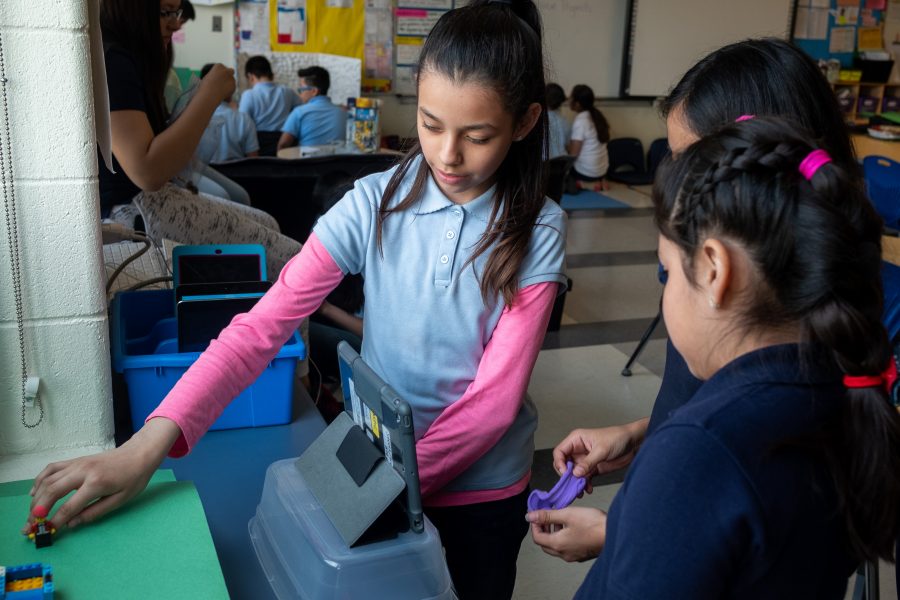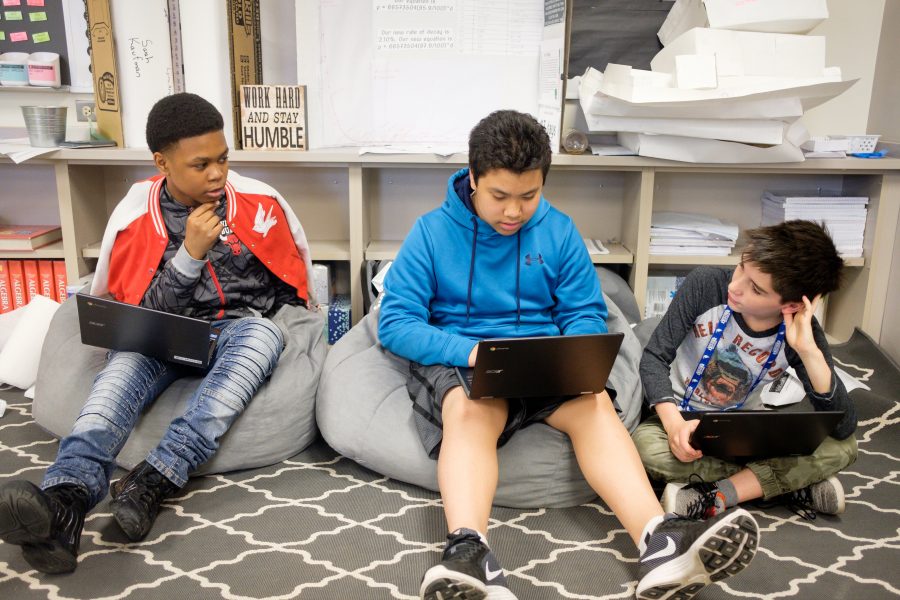Learner Demonstrated
Learners can progress at their own pace based on demonstrated mastery.
35%
more students earned As or Bs when a course was delivered with a competency-based instructional approach rather than a traditional approach.
*Fleming, R., Stoiber, L. c., Pfeiffer, H. m., Kienzler, S. e., Fleming, R. r., Pedrick, L. e., … Reddy, D. m. (2016). Using U-Pace instruction to improve the academic performance of economically disadvantaged undergraduates. Journal of Computer Assisted Learning, 32(4), 304–313.
How Do Learner Demonstrated Experiences Help Students?
Students make academic progress, tackle challenges, and improve perseverance when they are in classrooms that feature flexible but rigorous pacing and assessments. Teachers can make it safe to struggle and fail so that students recognize the importance of mastering a skill over just showing up for class and turning in required assignments.

The Guidelines of a Learner Demonstrated Experience
Learners begin at a challenging level appropriate to their prior knowledge and learning needs.
Use all available data to determine where a learner falls on the appropriate learning progression for major and sub skills.
Show Example
Example: A teacher and her learners regularly review data to set goals and adjust learning and instruction.
Show Strategy
Partner with learners to identify the most suitable learning format for their current academic level (e.g. class, groupings, activities, software).
Show Example
Example: A teacher has regular check-ins with individual learners after learning activities to discuss how successfully they learned something, and what that says for the types of learning activities they should focus on moving forward.
Show Strategy
Design learning experiences that explicitly connect new content to prior knowledge and skills.
Show Example
Example: Using a learner profile, a teacher intentionally designs mini-lessons to build upon her learners’ past experiences and strengths.
Show Strategy
Articulate short- and long-term learning expectations that are appropriate for learners’ current academic levels.
Show Example
Example: A teacher sets goals with learners on which steps of a project learners will complete in a week.
Show Strategy
Assess learners during the first parts of any lesson or unit to determine the starting points of their learning paths. Then, continue with dynamic, fluid changes to groups as needed to prevent “tracking.”
Show Example
Example: A teacher starts each class with an entrance ticket to check for understanding, then creates dynamic groups for mini-lessons or independent work that learners can opt into based on their needs.
Show Strategy
Learners receive feedback on effort, process, and mastery throughout every learning experience.
Provide feedback that is objective and non-judgmental to reinforce a learner’s sense of control for improving his or her mastery.
Show Example
Example: A teacher eliminates all language from his feedback that denotes fixed conditions such as “you’re smart” or “you’re talented.”
Show Strategy
Encourage learners to experiment and try multiple strategies to solve problems.
Show Example
Example: A teacher gives an assignment where learners are assessed not only by how successfully they solve a problem, but by how many ways they can think of to solve the problem.
Show Strategy
Encourage learners to reflect and report on effort and strategies as often as they do on results.
Show Example
Example: A teacher ends every class by having learners publicly share examples of peers putting forth great effort or using successful strategies.
Show Strategy
Learners advance or go deeper upon demonstration of mastery.
Create learning menus and vertical alignment of activities.
Show Example
Example: A teacher creates a document listing out multiple activities and sources of information for learning about and practicing a specific learning target. Students then choose which resources to use to reach the given target.
Show Strategy
Use formative assessment and learner feedback to enable advancement if a learner has mastered the objective needed to move onto the next objective.
Show Example
Example: Students are allowed to skip a unit test and move on to the next topic if they have shown mastery of the content through earlier quizzes and assignments.
Show Strategy
Allow learners to move through content at varied rates regardless of their starting level.
Show Example
Example: A teacher has designated “assessment blocks” during the week in which students may take mastery assessments on a topic when they feel ready.
Show Strategy
Provide a daily workflow of formative assessment, intervention, and feedback to learners.
Show Example
Example: A teacher establishes a transparent system using an online learning management system (LMS) for learners to take micro-assessments, receive or seek support based on results, and get direct feedback from a teacher or peer.
Show Strategy
Learners demonstrate learning in multiple ways.
Provide learners with access to multiple assessment options.
Show Example
Example: A teacher provides learners a menu of options for how to show their understanding of a concept.
Show Strategy
Support learners to co-create a rubric based on the learning objective(s).
Show Example
Example: A teacher and a subgroup of learners co-create a rubric that will be used for assessing their project.
Show Strategy
Co-design with learners multiple ways for demonstrating competency with standards.
Show Example
Example: A teacher works with her class to develop a menu of options for how to show understanding at the end of a unit (e.g. make a movie, draw a diagram, give a presentation).
Show Strategy
Leverage digital platforms and multimedia to capture multiple forms of learning and build an ePortfolio.
Show Example
Example: A teaching team shifts to an ePortfolio platform to capture all work on a daily basis and provide multiple means of documenting and showing learning progress.
Show Strategy
Partner with learners to select the content, product, or process they will use to demonstrate proficiency, as well as devise the methods that will be used to show evidence of their learning.
Show Example
Example: A teacher and learner work together to develop learning plans, including goals, strategies for learning, tools needed, and how learning will be demonstrated.
Show Strategy
Learners receive recognition based on demonstrated mastery, not time.
Identify which competencies need to be met to obtain credit, advance, and/or receive other recognitions for learning.
Show Example
Example: A team of teachers establishes a competency map across levels that enables assessments to be taken regardless of perceived “grade level.”
Show Strategy
Ensure that learners are clear about expectations and requirements for recognition.
Show Example
Example: A team of teachers adjusts their report card to be proficiency-based and holds regular mini-conferences with learners to check their understanding of their progress.
Show Strategy
Create an organized and accessible system for tracking evidence of learning (e.g. performance, assessment, credits, and competency progression).
Show Example
Example: A school team adopts a digital portfolio platform that is accessible to parents, learners, and teachers and provides transparent issuing of recognition for work.
Show Strategy
Change classroom policies for learning recognition and progression to take into account varying speeds of learner competency.
Show Example
Example: A teacher removes the weekly summative assessment on the same standard for all learners, and she implements a new system with flexibility—but with set expectations—around when learners demonstrate competency.
Show Strategy
What Does the Research Say?
Interventions that help teachers provide students with lessons at appropriately challenging levels consistently produced learning gains. This typically involved using pre-tests to gauge what students know and the supports they need to progress.1
When students learn at their own pace, get regular feedback, and move forward when they are ready, it improves student motivation and the belief that they can be successful learners, especially on mathematics tasks.2
When students learn at their own pace, get regular feedback, and move forward when they are ready, it improves student motivation and the belief that they can be successful learners, especially on mathematics tasks.2

1. Learner Demonstrated Guideline #1
Learners begin at a challenging level appropriate to their prior knowledge and learning needs
2. Learner Demonstrated Guideline #2
Learners advance or go deeper upon demonstration of mastery
